

#Azarius vuze how to
If you are unsure of how to open or forward ports please check your router/firewall manufacturers web site where you should be able to find a list of frequently asked questions or a knowledge base section, you may also be able to view an online user manual and in the vast majority of cases there will also be online support forums or blogs where you can look at a particular game or application and see whether other users have experienced the same problems, this is often a very good way to resolve a port forwarding issue, lots of users with similar computer hardware and internet connections may have experienced the same problem themselves and resolved it through online support forums or blogs, There may also be fan/clan or official website support pages where you can get information about Azureus (Vuze) online connection issues, you could also check the user manual that was supplied with your firewall or router, this should contain precise information that is specific to your router or firewall and should describe the process of opening or forwarding ports in easy to follow guides. Any ports for Azureus (Vuze) listed on this page should be opened or forwarded in your router/firewall to allow proper connection to an online server or dedicated server and/or when you want to host an online multiplayer game or application from your computer or local area network (LAN).
#Azarius vuze Pc
The information in this article is for the PC platform. Azureus (Vuze) router and firewall port information.If you select a port below 49152 make sure that the port number isn't already assigned to another application Ports can be selected for Azureus in the range listed above. A peer gets snubbed by taking more than 1 minute to send you a block (16k, so that's less than 300B/s), he gets un-snubbed if he sends you a block in less than 45 seconds.Publisher : The Azureus Team Developer : The Azureus Team Platform : PC Viewed : 12,353 timesĪpplication: AZUREUS Port range: 49152 - 65534 Protocol: TCP/UDP So you'll only queue him 1 request, and moreover you won't mark that block as being downloaded (so you'll request it from an un-snubbed peer too). When a peer is snubbed, you don't trust him anymore, until he gets un-snubbed. Snubbing: snubbing is a flag (computed, but that you can change manually), that indicates that a peer tells you he will send you data, but doesn't. We are trying to find better ways of unchoking when acting as a seed (but this is really not that easy). When you are a seed, snubbed people will never get unchoked (but Azureus won't snub anyone when you are seed), manually snubbing someone (right click on this peer in the details view) can let you control to who you DON'T want to send data (I hate leechers when I'm trying to seed with my 128kb adsl line). People that have the highest 'statistic upload' When seed, you'll unchoke ( Seed unchoking algorithm is the main thing to be optimized yet):

People that have globally uploaded you the maximum ammount of data People you are interested in (unless they are snubbed, or they have reached a share ratio of 1/10 (1b sent by them allow them to get 10 bytes) The best uploaders (which upload at least 256B/s) When peer, you'll unchoke in this order (until you have enough unchokes) : Unchoking is done every 10 seconds and optimistic unchoke is done every 30 seconds. The unchoking algorithm works in two different ways, depending on wether you are seed or peer. This way, you globally do rarest first, but you also try to finish pieces started. If a piece is already available on 10 peers, you'll choose to continue it, instead of starting a new one only available 8 times for example (8 is indeed less than 10 but not so much). That means, that if a piece is available only once on the network (ie the case with 1 seed, and a lot of peers), if the seed unchokes you, you will get a piece that no-one else has. The range used in today's implementation is of 90%. If you can continue a piece started (and not fully downloaded, or requested to others), you will continue that one. The main way it works is by doing rarest first, but using a range on rarest so that, the more the pieces are available, the more the range will be. It will queue up 10 requests on each peer that allows downloading from him/her.
#Azarius vuze download
Unlike other implementations, Azureus may download a single piece from several peers (the bigger the pieces, the more likely). The BitTorrent protocol lets you act mainly on two things : who you give data to ( unchoking), and when someone is ready to send you data, what you will get from him ( piece picking) (you won't saturate your upload stream, even by setting 14kB/s on a 16kB/s line) It uses a short time frame to compute upload rates, avoiding them to by-pass the limitation. The way this client deals with bandwith limitation seems better than others. Some technical aspects (old documentation, needs updating.)


 0 kommentar(er)
0 kommentar(er)
